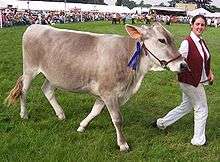Brown Swiss cattle
The Brown Swiss or American Brown Swiss is an American breed of dairy cattle. It derives from the traditional triple-purpose Braunvieh of the Alpine region of Europe, but has diverged substantially from it. It was selectively bred for dairy qualities only, and its draft and beef capabilities were lost. Milk yield was measured in 2013 at 10231 kg (22600 lb) per year;[2]:142 the milk has about 4% butterfat and 3.5% protein[3] and is suitable for making cheese.
 Heifer | |
| Conservation status | FAO (2007): not at risk[1]:143 |
|---|---|
| Other names | American Brown Swiss |
| Country of origin | United States |
| Distribution | world-wide |
| Use | |
| Traits | |
| Weight | |
| Coat | usually pale brown |
| |
In the twentieth century the Brown Swiss became a world breed, with a global population estimated in 1990 at seven million head. It has been much used for cross-breeding[2]:142 and has influenced a number of modern breeds.[3]
History
The Braunvieh is a traditional breed of triple-purpose cattle from the Alpine region, particularly Switzerland; it was reared as a draft beast, for its milk and for its meat. The Braunvieh was first imported to the United States in 1869, when seven cows and a bull were shipped to one Henry M. Clark in Belmont, Massachusetts.[4] Between then and 1906, when cattle imports to the United States were banned because of fear of disease, many more were imported, sometimes by immigrants arriving from Europe. The American Brown Swiss descends from a total of 167 imported parent animals.[2]:142 A breed society, the Brown Swiss Cattle Breeders' Association, was formed in 1880; the first herd-book dates from 1889. By the end of the century breeding was directed towards dairy qualities; a production register for cows was opened in 1911.[2]:142 From about 1940 the breed became more diffused across the United States. In the mid-twentieth century, intensive selective breeding for dairy characteristics and excessive inbreeding led to a loss of genetic diversity, and also to an increase in transmissible genetic defects such as the recessive factors for bovine progressive degenerative myeloencephalopathy ("weaver disease") and spinal muscular atrophy, both of which have a high percentage of carriers in the Brown Swiss (2.6% and 9.2% respectively).[2]:142[3][5]:6157
The Brown Swiss was exported – either on the hoof or in the form of embryos or semen – to many countries of the world. It has been much used for cross-breeding, notably with many of the original Alpine breeds of brown cattle in Austria, Germany and Switzerland. In 1990 the global population was estimated to be approximately seven million head.[2]:142
Characteristics
The American Brown Swiss is of medium size. The coat is usually a light grayish brown, but varies from almost white to gray or dark brown. There may some shading in the coat, with the forequarters often darker than the legs and hind parts. The muzzle is black, ringed with creamy white.[2]:142
Use
The milk of the Brown Swiss is unique, having longer-chain fatty acids than other popular dairy breeds and smaller fat globules in the cream; this difference means that cream rises much more slowly in milk from Brown Swiss cows.[6] This difference, and the ratio of protein to fat in the milk, is ideal for cheesemaking.[7]
References
- Barbara Rischkowsky, D. Pilling (eds.) (2007). List of breeds documented in the Global Databank for Animal Genetic Resources, annex to The State of the World's Animal Genetic Resources for Food and Agriculture. Rome: Food and Agriculture Organization of the United Nations. ISBN 9789251057629. Accessed January 2017.
- Valerie Porter, Lawrence Alderson, Stephen J.G. Hall, D. Phillip Sponenberg (2016). Mason's World Encyclopedia of Livestock Breeds and Breeding (sixth edition). Wallingford: CABI. ISBN 9781780647944.
- Marleen Felius (1995). Cattle Breeds: An Encyclopedia. Doetinchem, Netherlands: Misset. ISBN 9789054390176.
- BSCBA – USA 1869–1879. Beloit, Wisconsin: Brown Swiss Association. Archived October 15, 2010.
- P.M. VanRaden, K.M. Olson, D.J. Null, J.L. Hutchison (2011). Harmful recessive effects on fertility detected by absence of homozygous haplotypes. Journal of Dairy Science 94 (12): 6153–6161. doi:10.3168/jds.2011-4624. (subscription required).
- Milk composition of Holstein, Jersey, and Brown Swiss cows in response to increasing levels of dietary fat.
- "Dairy Dictionary". Archived from the original on 1 February 2016.
External links
| Wikimedia Commons has media related to Brown Swiss. |